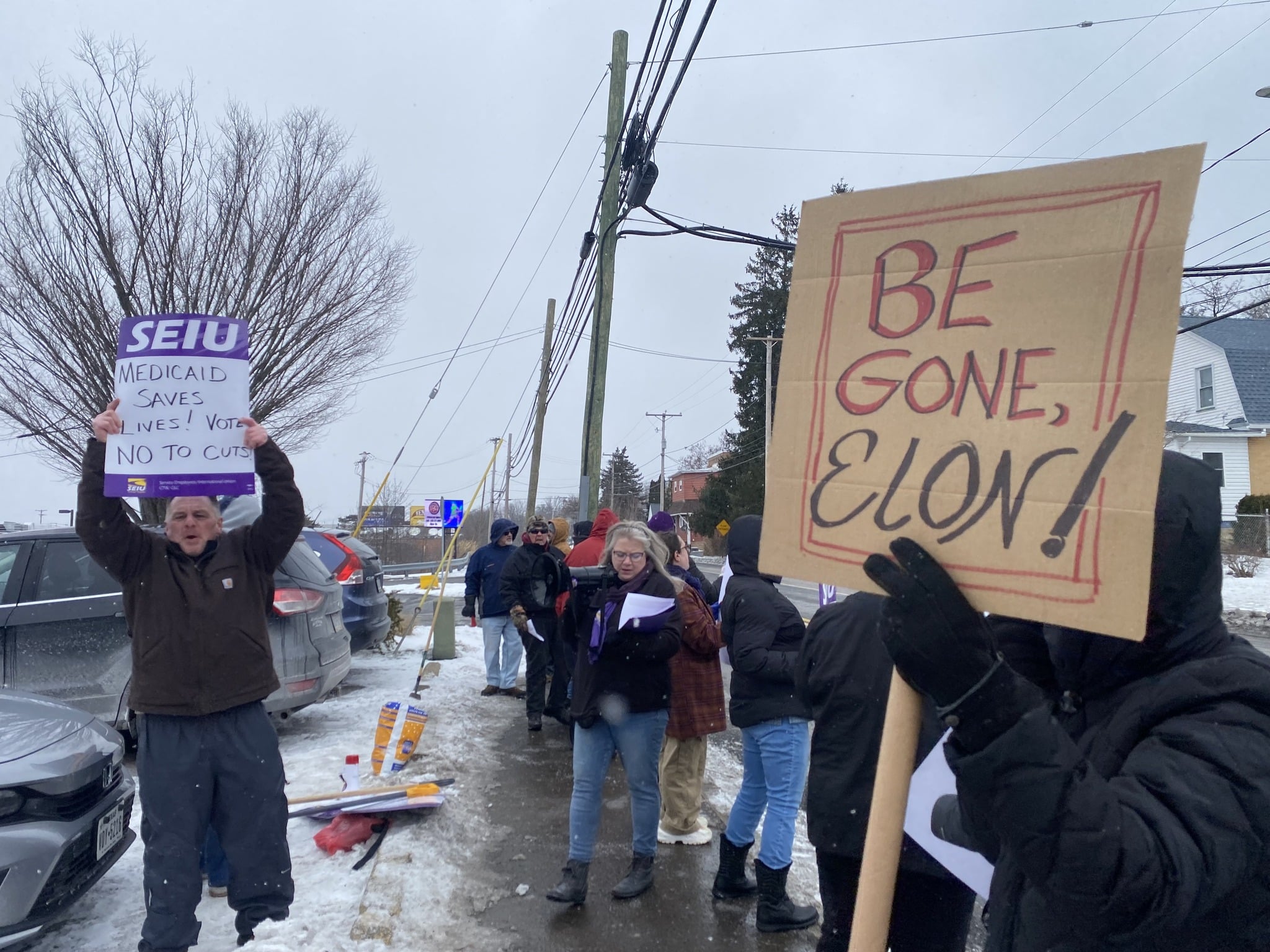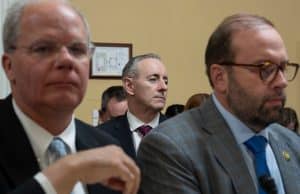Last month the national AFL-CIO re-affiliated with the SEIU. That means that the Service Employees International Union agreed to work in tandem with the American Federation of Labor and Congress of Industrial Organizations in hopes that together they’d be strong enough to pave the way for more than 60 million American workers who say they’d like to join a union, making that intention a reality.
On that grand scale, the impact could be great. With more than 2 million members, the SEIU greatly augments the power of the nearly 15 million strong AFL-CIO. But locally, in Bucks County, it may not make a whole lot of difference.
Steve Catanese, president of SEIU local 668, described the process of affiliation and what it means on the ground in Pennsylvania. “AFL-CIO is a federation of unions. Labor unions were gradually federated together to have more power.”
Catanese says that’s because the basic premise of organized labor is strength in numbers. Simply put, a group of workers agrees to leverage their combined power to convince an employer to change their working conditions – higher pay or shorter work weeks, for example.
When one organized group affiliates with another – say a group of organized truckers align with their counterparts on the assembly line – their leverage improves exponentially. One production facility can’t abuse the workers because then no production facility will have trucking. The pressure builds for worker rights and fairness.
While Catanese points out that even though the AFL-CIO was the “largest labor federation ever,” there came a time when “workers weren’t organizing.” In the 1980’s, up against a charismatic foe, unions took political heat that damaged their image and reputations. (Think Ronald Reagan and his penchant for union busting. Most famously by firing 11,000 air traffic controllers).
Since then, workers’ power has grown smaller.
Eventually, a number of unions dis-affiliated with the AFL-CIO. Catanese explained, “At the national level, some of the unions, SEIU was one, had a debate over ‘how do we grow more?’ Some of the unions left and formed a different federation called Change to Win.” Founded 20 years ago – Change to Win, now known as Strategic Organizing Center, still works to align, “unions, allies and frontline workers to develop strategies and implement tactics on transformational campaigns that confront corporate power.”
Catanese says that while there was a national Change to Win presence in Pennsylvania, “State by state a lot of the unions stayed in their state level AFL-CIO. My local, SEIU 668, we’ve always – ever since I was a member – we were still a member of the state AFL-CIO even if we weren’t nationally.” And Catanese, that affiliation has paid off when they needed it most.
Last year, for the first time ever, SEIU 668 went out on strike. This was before the new national agreement between SEIU and the AFL-CIO. Still, AFL-CIO affiliate AFSCME Council 13, stood by them. To Catanese and his counterpart, Tom Tosti, the Regional Director for the East for AFSCME council 13, this sort of support is too valuable to quantify.
Tosti – who also serves as President of the Bucks County Central Labor Council – said there was never a doubt that they would support the actions of SEIU 668 when needed. He explained that’s what the strength that comes from affiliation, “The support was the affiliates standing there, arm in arm, with SEIU – telling them, ‘If it went further, we would be there with you.’ Support knowing they weren’t out there alone there would be other affiliates there.”
Historically, when it has gone further, that’s the same support the Central Labor Council provided to the United Auto Workers (UAW) when they went out on strike in Bucks County, twice in recent memory. “We raised money for them. We made sure they all got gift cards to ShopRite. We would bring them pizza on the strike line. They were out there in the wintertime, so we actually had wood delivered for them.”
READ: 8 Ways States Can Fight Inequality and Build Worker Power
But now, as times grow dark on the national scene – with the illegal firing of National Labor Relations Board members “paralyzing” the NLRB – both Bucks County Labor leaders see the renewed alliance as essential.
Tosti says the Trump administration’s extra-constitutional actions go, “Bigger than the FBI.” He says the federal funding cuts to nearly every agency that sends dollars to the states for local government employees will be affected. “Sheriff’s department, prothonotary department, register of wills, clerk of courts, district attorney, residual units – people working in 911, court employees. All the court employees too, people who are in the district courts and in the regular courts in the county.” And those are just AFSCME folks. Tosti adds, “SEIU has probation and parole, operating engineers, and they have correction officers,” and many more.
And what will happen if that funding is cut? Tosti answered grimly, “Increase taxes or lay people off – do the purging he’s doing there in DC with what he calls wasteful spending.”
Catanese has one answer for that, “Personally, I’m not willing to surrender one worker right to Musk.” Referring, of course, to Elon Musk’s Department of Government Efficiency – a quasi-federal agency with zero legislative authority that is racing through agencies established and funded by congress gutting the departments that it hasn’t outright eliminated.
Rick Smith – member of the International Brotherhood of Teamsters and Pennsylvania based, nationally syndicated radio and television host – thinks organizing is the nation’s only hope for survival. “Congress obviously isn’t doing Jack.”
Smith sees party politics as decades of failed promises. The Republicans pretend to care about the worker while the Democrats pretend to push back. “We haven’t seen any real spine from the Democratic Party, and I don’t think we will.”
Smith continued, “We know that bullshit about when they go low, we go high. Well, Democrats had better figure out how when they go low, we jam their face in the dirt.”
People are afraid, and Smith gets that. But that doesn’t change his answer. “There is the message here and it is, ‘strength is numbers.’ Individually were easily attacked or easily fired or easily shut up. We’re easily divided, but together, unified, that’s the idea of solidarity.”
Smith continued, “I think we’re in that moment right now where we learn what solidarity means to working people or we allow ourselves to be steamrolled by people who are not being constrained by rules or regulations or laws?”
When failed by both parties – which had happened repeatedly in U.S. History, from the abolition movement to civil rights– Smith, Catanese and Tosti all agree, good old fashioned solidarity has always been the answer.
Catanese says that’s an uphill battle in PA. “Pennsylvania lags on workers’ rights because our general assembly has just been so anti-worker for so many years. The margins are a little bit better now, but we still have a $7.25 minimum wage.” Remarkably PA workers lack even the most basic rights held by federal employees. “For my members who are in the public sector, the public sector [employees] in Pennsylvania are not under the NLRB… [and] Pennsylvania is one of the states that has not opted in for OSHA rights.”
Tosti points out that the coming storm won’t just drench his affiliated workers. Everyone is getting wet. “This will be a trickle-down effect to the states – the states, the counties, the boroughs, the townships, and the school districts. Because once this [funding] is all eliminated, it’s going to fall back on the working-class people of Bucks County.”
Of Bucks County and beyond. Which is why new and bigger affiliations, like the one between AFL-CIO and SEIU, are necessary.
But not enough.
Rick Smith begs people – and union leadership – to, “start shutting things down, start doing the militancy that caused the National Labor Relations Act.”
Why?
Smith says, “The national labor relations act was not given. It was a peace treaty because our grandparents’ generation who were ripping this country apart – brick by brick – so that they could put food on the table. And out of all that came the most prosperous working class in the history of humanity.”







